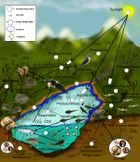تنافع
التنافع أو التكافل التبادلي (باللغة الإنجليزية: Mutualism) هو عبارة عن علاقة تعاونية حيوية بين نوعين أو أكثر من أنواع الكائنات الحية بحيث يستفيد الطرفان من هذا التعاون. ويمكن أن تكون ضرورية للنوعين (مجبرة) لا يستطيعان الاستغناء عنها أو اختيارية، وعندها تسمى بالتعايش التعاوني.
ويمكن ان نقول هو تفاعل بيولوجي بين طرفين والذي يكون مفيداً لكلا الطرفين المشتركين، إن أكثر حالات التنافع هو طوعي بمعنى أن كل عضو يستطيع أن يعيش على حده. مع ذلك، وممكن أن نشاهد أيضا بأن هناك من الطرفين من لا يستغني عن الآخر، أي أن لهم تبادل مشترك إلزامي وإجباري وأكثر التكافلات التبادلية هي تسحر تعقيداتها والمنفعة المتبادلة بينهم.
أنواع العلاقات
علاقات الخدمة-مصدر
علاقات الخدمة-خدمة

البشر والتنافع
النمذجة الرياضية
In 1989, David Hamilton Wright developed a mathematical explanation for mutualism using the Lotka–Volterra equation. Wright modified the Lotka-Volterra equations by adding a new term, βM/K, to represent a mutualistic relationship.[1]
The mutalistic relationship is quantified by:
حيث،
- N and M = the population density
- r = intrinsic growth rate of the population
- K = carrying capacity of its local environmental setting.
- β = coefficient converting encounters with one species to new units of the other
الرد الوظيفي من النمط الثاني
حيث،
- a = the instantaneous discovery rate
- x = food item density
- TH = handling time
The equation that incorporates Type II functional response and mutualism is:
حيث،
- N and M = density of the two mutualists
- r = intrinsic rate of increase of N
- c = coefficient measuring negative intraspecific interaction
- X = 1/a TH
- β = b/ TH
- a = instantaneous discovery rate
- b = coefficient converting encounters with M to new units of N
وبإعادة الترتيب:
انظر أيضاً
- تطفل
- مطاعمة
- معايشة
- تعايش تعاوني
- تنافس اقصائي
- Arbuscular mycorrhiza
- Co-adaptation
- Co-evolution
- Ecological facilitation
- Frugivory
- Greater Honeyguide - has an interesting mutualism with humans
- Interspecific communication
- List of symbiotic relationships
- Müllerian mimicry
- Mutualisms and Conservation
- Mutual Aid: A Factor of Evolution
- Symbiogenesis
الهامش
- ^ Wright, David Hamilton. 1989. A Simple, Stable Model of Mutualism Incorporating Handling Time. The American Naturalist, Vol. 134, No. 4, pp. 664-667.
المراجع
- Breton, Lorraine M., and John F. Addicott. 1992. Density-Dependent Mutualism in an Aphid-Ant Interaction. Ecology, Vol. 73, No. 6, pp. 2175–2180.
- Bronstein, JL. 1994. Our current understanding of mutualism. Quarterly Review of Biology 69 (1): 31-51 March 1994
- Bronstein JL. 2001. The exploitation of mutualisms. Ecology Letters 4 (3): 277-287
- Bronstein JL. 2001. The costs of mutualism. American Zoologist 41 (4): 825-839 S
- Bronstein JL, Alarcon R, Geber M. 2006. The evolution of plant-insect mutualisms. New Phytologist 172 (3): 412-428
- Denison RF, Kiers ET. 2004. Why are most rhizobia beneficial to their plant hosts, rather than parasitic? Microbes and Infection 6 (13): 1235-1239 ISSN 1286-4579
- DeVries, PJ; and Baker, I. 1989. Butterfly exploitation of an ant-plant mutualism: Adding insult of herbivory. Journal of the New York Entomological Society [J. N.Y. ENTOMOL. SOC.]. Vol. 97, no. 3, pp. 332–340. ISSN 0028-7199
- Hoeksema, J.D. & E.M. Bruna. 2000. Pursuing the big questions about interspecific mutualism: a review of theoretical approaches. Oecologia 125:321-330 ISSN 0029-8549
- Jahn, G.C. and J.W. Beardsley. 2000. Interactions of ants (Hymenoptera: Formicidae) and mealybugs (Homoptera: Pseudococcidae) on pineapple. Proceedings of the Hawaiian Entomological Society 34: 181-185. ISSN 0073-134X
- Jahn, Gary C., J. W. Beardsley and H. González-Hernández 2003. A review of the association of ants with mealybug wilt disease of pineapple. Proceedings of the Hawaiian Entomological Society. 36:9-28.ISSN 0073-134X
- Noe, R. & P. Hammerstein. 1994. Biological markets: supply and demand determine the effect of partner choice in cooperation, mutualism and mating. Behavioral Ecology and Sociobiology 35:1-11 ISSN 0340-5443
- Ollerton, J. 2006. "Biological Barter": Patterns of Specialization Compared across Different Mutualisms. pp. 411–435 in: Waser, N.M. & Ollerton, J. (Eds) Plant-Pollinator Interactions: From Specialization to Generalization. University of Chicago Press. ISBN 978-0-226-87400-5
- Paszkowski, U. 2006. Mutualism and parasitism: the yin and yang of plant symbioses. Current Opinion in Plant Biology 9 (4): 364-370. (DOI:10.1016/j.pbi.2006.05.008. PMID 16713732
- Porat, D. & Chadwick-Furman, N. E. 2004. Effects of anemonefish on giant sea anemones:expansion behavior, growth, and survival. Hydrobiologia 530, 513–520. DOI:10.1007/s10750-004-2688-y
- Porat, D. & Chadwick-Furman, N. E. 2005. Effects of anemonefish on giant sea anemones: ammonium uptake, zooxanthella content and tissue regeneration. Mar. Freshw. Behav. Phys. 38, 43–51. DOI:10.1080/102362405000_57929
- Thompson, J. N. 2005. The Geographic Mosaic of Coevolution. University of Chicago Press. ISBN 978-0-226-79762-5
- Wright, David Hamilton. 1989. A Simple, Stable Model of Mutualism Incorporating Handling Time. The American Naturalist, Vol. 134, No. 4, pp. 664–667.
للاستزادة
- Boucher, D. G., James, S. & Kresler, K. (1984) The ecology of mutualism. Annual Review of Ecology and Systematics, 13: 315-347.
- Boucher, D. H. (editor) (1985) The Biology of Mutualism : Ecology and Evolution London : Croom Helm 388 p. ISBN 0-7099-3238-3





